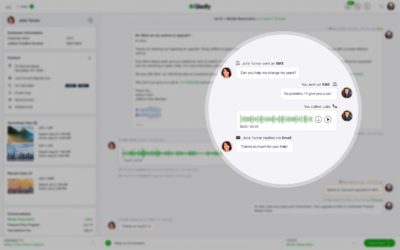At work, I specialize in both an industry (travel and transportation) and a “competency” (customer experience). I’m always interested in developments in each space, but I get especially jazzed when something newsworthy happens in the intersection between the two. And that’s exactly what’s happened with JetBlue’s announcement that they are teaming up with Gladly to create a new omnichannel customer service system.
When you think about the different touchpoints a customer has with a brand, there are a lot of different channels. You might shop for clothes online, but return them to a physical store. (I know I’m not the only one who does that to save on return shipping!) You might buy an iPhone directly from Apple or you might buy it third-party from Best Buy. And you might post on social media about an airline, but then end up calling them about the same issue. That last scenario is what JetBlue is hoping to improve.
It’s not always easy for a brand to follow customers as they go from channel to channel. Sure, brands like Marriott have encouraged guests to link their social media accounts with their loyalty program profiles, but that’s still pretty cumbersome for a customer service agent to search all your accounts when they talk to you – even if they know who you are across platforms. Realistically, they’re not going to take the time to do that.
This spring, though, JetBlue invested in a startup that will make it possible for customer service agents to easily see all your interactions with the airline – regardless of the communication channel. So if you tweet JetBlue about something and then call in, the agent who answers will already have the background of the issue you’re calling about, and you won’t need to repeat yourself or provide a “case number” from a past interaction. While case numbers can make it easy to pull up history, they also start the interaction on the wrong foot, implying that you’re just a number to them rather than a person with a real problem. That kind of smart history alone is a pretty big win!

Where this technology gets really exciting, though, is the context it can provide and the subsequent impacts on personalization. Let’s say you post on Instagram that you’re excited about relaxing on vacation with your family, and you tag JetBlue in the post. When you later call to complain about your bags going missing, the agent can see that you were pretty pumped to fly JetBlue, and express sympathy for how your lost luggage must be impacting your family vacation. That kind of personalization and understanding can go a long way toward improving your customer experience, even before the issue itself is solved.
And if we really want to get forward thinking in how we use omnichannel data to build a profile, we can look to the chatbots that several airlines are starting to use. Chatbots themselves aren’t a new thing – Alaska Airlines introduced “Ask Jenn” more than ten years ago, and today, Aeromexico, Volaris, Lufthansa, and KLM have all begun using Facebook Messenger chatbots to solve basic problems. When 80% of customers ask the same same questions, bots can provide easy answers… but with tools like Gladly, interactions can provide an even better experience.
What’s evolving in the world of chatbots is the ability to provide personalized answers based on an individual customer profile, rather than providing the same generic answers to everyone. If your chatbot has no idea who the customer is or why they’re on your site, they’re not much more helpful to a customer than a long FAQ page with a search tool. Armed with an omnichannel customer profile, the chatbot can use the context of your compiled interactions to more comprehensively assess and answer your questions – all without a human having to get involved.
Of course, the role of humans in customer service won’t go away completely… nor should it. But Gladly can still help humans too, by ensuring a consistent response across all channels and times of response. Many companies split their service reps by channel (e.g., one team handles email and another handles phone calls), which can lead to a very disjointed experience. Marrying responses from one channel to the next can ensure cohesiveness both of the answer itself, and the brand / tone in which it’s communicated.
The airline industry has a terrible reputation for customer service, even as actual customer satisfaction is at an all-time high. I think that misperception is largely because emotions and stress levels are so high when people are away from home – in the moment, you’re livid because you’re already stressed out, but just a few days later, you’re not nearly as upset. That negative experience is certainly not helped by the cattle call-like atmosphere of many airports, or the tightness of seat pitch in coach. But I’d argue that one answer to that problem is an increase in personalization – the ability to feel like a real person rather than just a number. Gladly is a great step in the right direction from one of my favorite carriers, and I’m excited to see other airlines follow in JetBlue’s footsteps and build more comprehensive omnichannel customer profiles.
